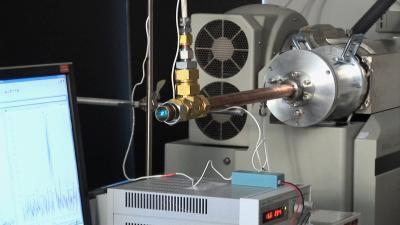RICHLAND, Wash. – A quick, accurate and highly sensitive process to reliably detect minute traces of explosives on luggage, cargo or travelling passengers has been demonstrated by scientists at the Department of Energy's Pacific Northwest National Laboratory. The vapor detection technology accurately detects and identifies the vapors of even very low-volatility explosives in real time at ambient temperature and without sample pre-concentration. Details are outlined in a recent issue of Analytical Chemistry.
Rather than searching for particle residue using a typical method like surface swipes or using pulses of air to dislodge particles for analysis, the system 'sniffs' directly for explosives vapors, much the way bomb-sniffing canines do.
"We have demonstrated direct, real-time vapor detection for the low-volatility explosive compound RDX, which is used in many types of explosives," said David Atkinson, senior research scientist at PNNL. Low-volatility compounds are those which release very small amounts of the explosive vapor typically at parts per trillion levels or lower, making it extremely difficult to detect. The PNNL system easily detects vapors from a fingerprint-sized sample of RDX at levels below 25 parts per quadrillion.
"The system correctly identified the RDX vapor using selective atmospheric pressure chemical ionization with mass spectrometry," explained Atkinson. The approach involves pulling an air sample stream and ionizing it within a reaction region in an atmospheric flow tube. The ionized sample moves to a mass spectrometer for ion detection and identification. These air samples need no heating or pre-concentrating. Analysis happens in about one second.
"The key part is ionization," said Atkinson. "We tailored the chemistry to greatly enhance both ionization efficiency and selectivity, which results in the best possible detection."

While a commercial-off-the-shelf mass spectrometer is used, the truly unique capability analysis lies in PNNL's ionization chemistry approach developed on the front end of the system.
(Photo Credit: PNNL)
Only a limited number of ultra-sensitive detection methods have been found capable of detecting low-volatility explosive compounds at levels below parts-per-trillion. But these methods typically take much longer and require pre-concentration of the sample from the vapor phase.
Currently, most airport security agents use cloth-like material to swipe luggage and cargo to collect explosives particles for detection. The samples are then analyzed one at a time in a process that requires the swipe to be heated to a temperature needed to volatilize the particles for detection.In some cases, airport security will turn to canines for detection, especially for large items where size such as vehicles or cargo make particle sampling impractical.
"What we are attempting to develop is an instrument that replicates or surpasses the capabilities of a dog," said Atkinson. However, while canine olfactory systems are highly developed, dogs present issues that machines don't. Man's best friend only works limited hours, must be fed, exercised regularly and rested. While a dog's ability to smell and detect explosives is extremely sensitive, instruments may soon surpass their capabilities and perform at a lower cost.
Robert Ewing, PNNL senior research scientist, sees a bright future for the technology and is hoping to push the performance even further.
"Currently we have demonstrated the detection of explosive compounds such as RDX, PETN, nitroglycerine and tetryl, along with plastic explosives that contain these materials at low parts per quadrillion levels," said Ewing. "Future research will focus on detecting other explosive threats by manipulating the ionization chemistry and lowering detection limits."